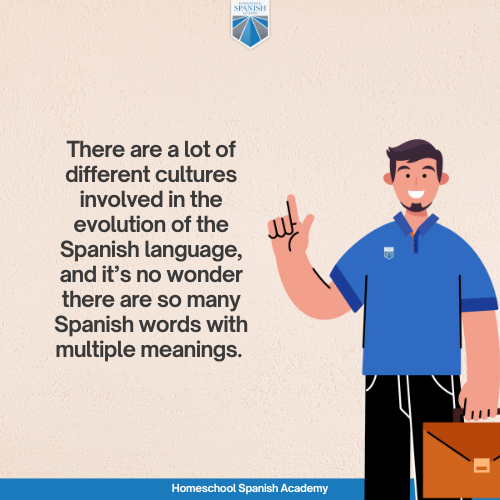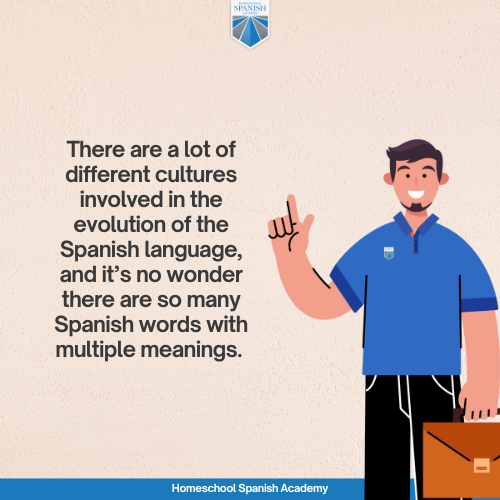Notifications
ALL BUSINESS
COMIDA
DIRECTORIES
ENTERTAINMENT
FINER THINGS
HEALTH
MARKETPLACE
MEMBER's ONLY
MONEY MATTER$
MOTIVATIONAL
NEWS & WEATHER
TECHNOLOGIA
TV NETWORKS
VIDEOS
VOTE USA 2026/2028
INVESTOR RELATIONS
COMING 2026 / 2027
ALL BUSINESS
COMIDA
DIRECTORIES
ENTERTAINMENT
FINER THINGS
HEALTH
MARKETPLACE
MEMBER's ONLY
MONEY MATTER$
MOTIVATIONAL
NEWS & WEATHER
TECHNOLOGIA
TV NETWORKS
VIDEOS
VOTE USA 2026/2028
INVESTOR RELATIONS
COMING 2026 / 2027
About Me
 Latinos Media
Latinos Media Latinos Media provides all types of news feeds on a daily basis to our Members
Posted by - Latinos Media -
on - October 24, 2023 -
Filed in - Noticias -
-
0.9K Views - 0 Comments - 0 Likes - 0 Reviews

Did you know that there are plenty of Spanish words with multiple meanings?
You may learn a word in one Spanish-speaking country and then travel to a different one, where that word has an entirely different meaning. Moreover, sometimes this can happen inside the same country!
Do you want to know and learn how to use these words?
Keep reading all about the Spanish words with multiple meanings, what history has to do with them, and why cultural context is crucial to understanding them.
Besides you will also learn ten of these words with explanations and examples of how to use them.
Join 559 million people on the planet who speak Spanish!
Sign up for your free trial Spanish class today. 

Languages have, for many different reasons that we’ll analyze in a moment, words with double meanings; sometimes, they can even have three or more!
Although this phenomenon isn’t exclusive to the Spanish language, it’s particularly common to find Spanish words with multiple meanings due to their history and geography.
So, why do some words have different meanings? Well, there are several reasons for that, but the main ones may be cultural factors, considerable distances, and history.
When you take a closer look at the history of the Spanish language, you will find the different influences it had.
First, it evolved from Latin. Then it was heavily influenced by 700 years of Arabic rule on the Iberian peninsula and also by the 500 years of interaction with the pre-Hispanic languages of the Americas.
Think about that for a minute.
Those are 1,200 years of close contact with different languages. This means that that words move from one language to another. Crucially, these words may get different meanings in other contexts.
Influence of Cultural Factors in the Interpretation of WordsWhile history definitely plays a significant role in these Spanish words with multiple meanings, cultural factors may be the biggest single factor when discussing this topic.
The Latin American context means that many countries over a vast land extension from Mexico to Argentina share the same language: Spanish.
Many phrases and words in Spanish are different in each country.
When you cross a border, you enter into a completely different culture, and that culture’s context may have changed the meaning of a word through the years.
For instance, while patas means “feet” in most Spanish-speaking countries, in Perú, it refers to your “friends.”
If you aren’t from Perú, you don’t have the cultural context to understand why the word patas doesn’t refer to “feet” but means “friends.”
That’s why cultural factors play a prominent role in understanding and interpreting Spanish words with multiple meanings.
What About Homonyms and Polysemes?Homonyms “are two words spelled the same but also different and have different meanings.” They even have different roots and come from different contexts. They just happen to be spelled in the same way.
Think of the English word “bat,” which refers to an animal and to a long stick used to hit a ball in baseball.
An example of a homonym in Spanish is llama, which refers to the South American animal, and it’s also a conjugation of the verb llamar or “to call.”
On the other hand, polysemes are Spanish words with multiple meanings.
They’re the same words, but they have developed different meanings for different reasons, such as context, culture, and history.
Below, you will find some examples of these words.
10 Spanish Words That Mean Different ThingsLet’s now get to know ten different Spanish words with multiple meanings, learn about their context, and how to use them.
1. GuaguaIn several Latin American countries, including Puerto Rico and the Dominican Republic, guagua simply means “bus.” However, in Chile, a guagua is a baby.
Examples:Me voy en guagua. (Puerto Rico, Dominican Republic)
I’ll go by bus.
¡Qué lindo guagua! (Chile)
What a beautiful baby!
2. ChuchoChucho is one of those Spanish words with multiple meanings that doesn’t stop at only two but has several ones.
In México, people call Chucho to someone who’s called Jesús. However, in Chile, a chucho is a jail, and in El Salvador and Guatemala, it refers to a stingy person. But, also in México and Central America, it can reffer to a dog.
Examples:Ése es el hermano de Chucho. (México)
That’s Chucho’s brother.
Llevaron a Carlos al chucho. (Chile)
They took Carlos to jail.
Miguel es un chucho. (El Salvador, Guatemala)
Miguel is so stingy.
¡Mira, qué chucho tan bonito! (México, Central América)
Look, what a beautiful dog!
3. TortaIn most Spanish-speaking countries and Spain, a torta is a cake. However, in México, a torta is a sandwich made with baguette type of bread, and it can include everything from ham and cheese to meat, sausages, eggs, and avocado.
Examples:¿Te gustó la torta de cumpleaños de María? (Everywhere, but México)
Did you like María’s birthday cake?
Quiero una torta de jamón con queso y tomate por favor. (México)
I want a sandwich of ham with cheese and tomato, please.
4. TortillaLet’s stay with the food once we already started with the subject.
In Spain, a tortilla de patata is a potato omelet, one of Spain’s most traditional dishes.
However, in Mexico, a tortilla is a corn-based (although you can now find wheat-made, too) type of flatbread used to make tacos, quesadillas, and enchiladas, among many other things.
Examples:Mi abuela hacía la mejor tortilla de patata del mundo. (Spain)
My grandmother used to made the best potato omelette in the world.
¿Me das una tortilla caliente para hacerme un taco? (México)
Can you give a hot tortilla to make myself a taco?
5. BuzoWhile a buzo is a diver in most Spanish-speaking countries, in Argentina, it also means “sweatshirt,” and in Costa Rica and Chile, it means “sweatpants.”
Examples:Mi tío es buzo profesional. (Most Spanish-speaking countries)
My uncle is a professional diver.
Deja me pongo el buzo. (Argentina)
Let me put on my sweatshirt.
Olvidé el buzo en casa. (Costa Rica and Chile)
I left my sweatpants at home.
6. MacheteIn standard Spanish, a machete is a long knife, almost like a sword, used to cut field weeds.
Nevertheless, in Colombia and Argentina, machetes are those pieces of paper used by students to cheat on exams.
Examples:¿Puedo usar tu machete? Necesito cortar unas hierbas de mi jardín. (Most Spanish-speaking countries)
Can I use your machete? I need to cut some weeds from my garden.
Jorge tenía todas las respuestas en su machete. (Colombia and Argentina)
Jorge had all the answers on his cheat sheet.
7. ChuletaTalking about cheat sheets, in Spain, a chuleta, besides being a lamb chop like everywhere else, is also a cheat sheet.
Examples:Estas chuletas están deliciosas. (Standard Spanish)
These lamb chops are delicious.
Jorge tenía todas las respuestas en su chuleta. (Spain)
Jorge had all the answers on his cheat sheet.
8. ChambaIn México and Central America, chamba means “work,” “job,” or “gig.” However, in Colombia and Venezuela, it means “trench” or “ditch.”
Examples:No puedo encontrar ninguna chamba. (México)
I can’t find any job.
Esta chamba se inunda con facilidad. (Colombia and Venezuela)
This ditch gets flooded too easily.
9. PistoPisto means “money” in Central American countries, but in México, it refers to liquor or alcoholic drinks.
Examples:No tengo pisto para pagar la renta. (Central America)
I have no money to pay the rent.
Vamos a comprar más pisto. (México)
Let’s go to buy more drinks.
10. FresaIn most Spanish-speaking countries, a fresa is a strawberry (not in Argentina, where they call it frutilla).
However, in México, a fresa is one of those Spanish words with multiple meanings as it can be used to refer to the fruit but also to a posh person.
Examples:Quiero un helado de fresa. (Everywhere, but Argentina)
I want a strawberry ice cream.
Karina es muy fresa. (México)
Karina is very posh.

Languages are living organisms that evolve over time.
Other languages and cultures influence them; they get new words from immigrants or conquered people and change the meaning of their own words from one region to another.
The Spanish language is no stranger to this evolution, and its history has much to do with its fantastic richness.
There are a lot of different cultures involved in the evolution of the Spanish language, and it’s no wonder there are so many Spanish words with multiple meanings.
Learning about these words is an important step in your journey to achieve fluency in the language because it’s about getting new vocabulary and understanding cultural differences.
Sign up for a free trial class with one of our certified, native Spanish-speaking teachers from Guatemala.
We’ve been teaching Spanish for over ten years. We offer flexible scheduling and student-tailored Spanish programs.
What’s more, you’ll learn about Spanish words with multiple meanings and speak Spanish from your first class.


“This is the best way for your kid to learn Spanish. It’s one-on-one, taught by native Spanish speakers, and uses a curriculum.”
– Sharon K, Parent of 3

“It’s a great way to learn Spanish, from native Spanish speakers in a 1-on-1 environment. It’s been fairly easy to schedule classes around my daughter’s other classes. The best value for us has been ordering multiple classes at a time. All the instructors have been great!”
– Cindy D, Parent of 3

“HSA offers very affordable, quality, one on one classes with a native speaker. My son has greatly benefited from taking classes. We have seen his confidence increase as well as his pronunciation improve because he learns from a native Spanish speaker. HSA has quick, personal customer service. Our family has been very pleased with our experience so far!”
– Erica P. Parent of 1
The post Spanish Words with Multiple Meanings in Latin America appeared first on Homeschool Spanish Academy.